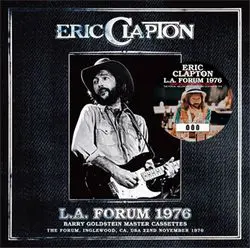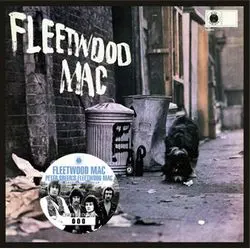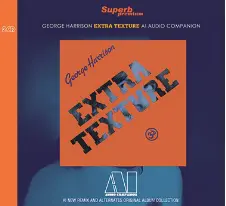Description
The Forum, Inglewood, CA, USA 22nd November 1976 TRULY PERFECT SOUND
[The original master of the final performance of the “No Reason to Cry US Tour” appears!]
After 49 years, the master of the famous taper’s historical sound source has appeared! This is a master that completely recorded the concert at the LA Forum on November 22nd, the final performance of the US tour that Clapton performed in the fall of 1976 to promote the album “NO REASON TO CRY”, with a very wide and clear mono audience recording (the sound field can be said to be stereo).
In fact, there is a previously released version of this sound source, and at the time of its release it was labeled as a recording by that “Mike Millard”, but this time JEMS researched it and found out that it was the master of Millard’s close friend taper Barry Goldstein (who lives in Southern California), and uploaded a direct transfer from his master cassette (Millard did not record Clapton’s concert that year). Goldstein’s seat was the front row of the arena, section C, and the equipment used was a Sony cassette recorder TC-55. The previously released version was probably produced from a cassette copy of the master, so some deterioration in sound quality is inevitable at that point. In contrast, this work is produced from file data digitally transferred from this original master, so JEMS himself has stated that it is the highest quality ever, surpassing the previously released version. The previously released version was also of quite high quality, so it was not unreasonable to mistake it for a Millard recording, but this work goes even further than that. Please check out the quality of the original master of the famous 1976 sound source that has emerged after 49 years.
[A great recording of Clapton at his best on a variety-rich set!]
Here is a summary of Clapton’s activities this year:
・July 29th to August 17th, 1976: UK tour
≪August 1st, 1976: Album “NO REASON TO CRY” released≫
・November 5th to 22nd, 1976: US tour ←★Here★
・November 26th, 1976: The Band’s farewell concert “The Last Waltz” held
You can see that this LA performance was the final day of the tour. The sound quality of this work, which captures it, is truly “excellent”, a clear and spacious mono recording, and is recorded with a very easy-to-listen-to sound.
Badge and I Shot The Sheriff (reprise), which seem to have been tape changes, are cut in, but the appeal is that the concert is completely recorded with this sound quality (encores were not included in “Norman 1976” and “San Diego 1976” that we have already released).
Furthermore, since it was the final day of the tour, Clapton was in high spirits, especially considering that he was scheduled to appear at The Band’s breakup concert “The Last Waltz” after this. As proof of this, the entire show was a wonderful one, full of Clapton’s spirit.
From the opening, two acoustic numbers from the album “NO REASON TO CRY” are performed standing up. The guitar used is a vintage Martin 000-28. It was my favorite Martin during this period. Then I changed to electric. Of course I got the “Blackie” Strat. The sharp and flowing solo in the sudden Tell The Truth is amazing. Then I performed a number from the new album again, and the performance of Double Trouble was so good that I thought, “What?! Are you going to bring it to the peak already at this early stage?” That doesn’t mean it goes downhill from here, but Clapton is in top form throughout the whole day. You can feel that here as early as possible.
The next song, All Our Past Times, was originally arranged with Clapton holding a Martin guitar and George Terry playing the guitar solo, but this electric version, which also features Clapton’s solo, is by far the better song. Clapton’s relaxed electric solo, which imitates the studio version, is very tasteful. George Terry takes the vocals for the second chorus and the first guitar solo. In fact, four days later, Clapton also plays this song in “The Last Waltz” after the end of the tour. Clapton’s head on this day may have been thinking of it as a rehearsal for the performance four days later.
Key To The Highway, which he has been playing for 55 years now, is a thrilling piece, with a relaxed yet rapid-fire performance near the end. The solo in the middle of Badge is also Clapton-like and elegant. In addition to Double Trouble, Have You Ever Loved A Woman is also included, which is typical of the bluesman Clapton. The playing is impeccable, and it can be said that this is a masterpiece comparable to the same song on the live album “EC WAS HERE”.
And it’s surprising that Layla, which is usually the finale of the regular set, is played in the middle of the set. In the long solo at the end, Clapton plays hard, and at the end, it’s amazing how it develops into a twin lead composition with George Terry. This is all improvisation, so I can only say that it’s impressive.
From here on, the music becomes even more varied. He puts in a lot of energy into the powerful Blues Power, but then he plays I Shot The Sheriff. Moreover, this song is played in a rare arrangement with drum and percussion solos in between. The drum solo by Jamie Oldaker, who has been enhancing the songs with his sharp drumming since 1974, is also rare, but the feeling-oriented percussion solo by percussionist Sergio Pastora Rodriguez, who was only with the band during this period, is also worth listening to. Perhaps Clapton had a good image of his collaboration with Carlos Santana on the previous year’s tour, and he wanted a groove like Santana. He probably wanted that free Latin groove.
The final encore, Further On Up The Road, is also included. Clapton played tirelessly even at the end. He played run-style, trill-style, and sharp phrases. This song was also performed at “The Last Waltz” four days later. Clapton must have been looking forward to playing with Robbie Robertson that day, and was imagining it as he played. This groove is unique to this band. It’s great to see the full potential of the Tulsa Tops, who supported Clapton in the 70s after his comeback, and I hope you’ll also listen to the wonderful playing of Jamie Oldaker and Carl Radle, who plays a groove-filled bass line, and Dick Sims, who plays an atmospheric organ.
Incidentally, it seems that members of Fleetwood Mac and Ringo Starr were watching this stage. They must have been impressed to see Clapton in top form. Listening to this, I feel that Clapton’s own blues, which he aimed for as a solo artist, “Clapton’s Blues”, was completed during this period, incorporating the laid-back taste of the real America. This is the rock that only he could create, weaving a majestic performance rooted in the American continent with a slightly shadowy yet thrilling play unique to British guitarists. If you think “Clapton in the late 70s was also inclined towards country and was loose”, listening to this work will overturn that stereotype. The original master of the LA performance that appeared after 49 years. Please take this opportunity to check out the true essence of Clapton, who was generous in the 70s, but still sharp, with this work.
Disc:1 (53:54)
1. Intro.
2. Hello Old Friend
3. Sign Language
4. Tell The Truth
5. Double Trouble
6. All Our Past Times
7. Knockin’ On Heaven’s Door
8. Key To The Highway
9. Can’t Find My Way Home (feat. Yvonne Elliman)
10. Badge
Disc:2 (50:55)
1. Have You Ever Loved A Woman
2. Layla
3. One Night (feat. Marcy Levy)
4. Blues Power
5. I Shot The Sheriff
6. Drum & Percussion Solo
7. I Shot The Sheriff (reprise)
8. Further On Up The Road




